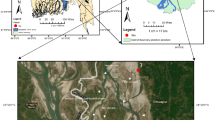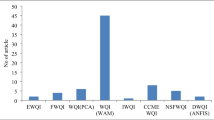Abstract
The UNEP GEMS/Water Programme is the leading international agency responsible for the development of water quality indicators and maintains the only global database of water quality for inland waters (GEMStat). The protection of source water quality for domestic use (drinking water, abstraction etc) was identified by GEMS/Water as a priority for assessment. A composite index was developed to assess source water quality across a range of inland water types, globally, and over time. The approach for development was three-fold: (1) Select guidelines from the World Health Organisation that are appropriate in assessing global water quality for human health, (2) Select variables from GEMStat that have an appropriate guideline and reasonable global coverage, and (3) determine, on an annual basis, an overall index rating for each station using the water quality index equation endorsed by the Canadian Council of Ministers of the Environment. The index allowed measurements of the frequency and extent to which variables exceeded their respective WHO guidelines, at each individual monitoring station included within GEMStat, allowing both spatial and temporal assessment of global water quality. Development of the index was followed by preliminary sensitivity analysis and verification of the index against real water quality data.
Similar content being viewed by others
References
Beldowski, J., & Pempkowiak, J. (2007). Mercury transformations in marine coastal sediments as derived from mercury concentration and speciation changes along source/sink transport pathway (Southern Baltic). Estuarine, Coastal and Shelf Science, 72, 370–378. doi:10.1016/j.ecss.2006.10.007.
Buszewski, B., & Kowalkowski, T. (2003). Polands environment—past, present and future state of the environment in the Vistula and Odra river basins. Environmental Science and Pollution Research, 10, 343–349.
CCME (2001). Canadian water quality guidelines for the protection of aquatic life: CCME Water Quality Index 1.0, user’s manual. In Canadian environmental quality guidelines, 1999, Canadian Council of Ministers of the Environment, Winnipeg, Manitoba. Retrieved on March 29, 2007, from http://www.ccme.ca/assets/pdf/wqi_usermanualfctsht_e.pdf.
CCME (2005). Canadian environmental sustainability indicators. Freshwater quality indicator: Data sources and methods. Catalogue no. 16-256-XIE. Retrieved on March 29, 2007, from http://www.statcan.ca/bsolc/english/bsolc?catno=16-256-XIE#formatdisp.
Cude, C. G. (2001). Oregon water quality index: A tool for evaluating water quality management effectiveness. Journal of the American Water Research Association, 37, 125–137.
Esty, D. C., Levy, M. A., Srebotnjak, T., de Sherbinin, A., Kim, C. H., & Anderson, B. (2006). Pilot 2006 environmental performance index. New Haven, USA: Yale Center for Environmental Law & Policy.
Gueguen, C., & Dominik, J. (2003). Partitioning of trace metals between particulate, colloidal and truly dissolved fractions in a polluted river: The Upper Vistula River (Poland). Applied Geochemistry, 18, 457–470.
Harkness, S. (2004). Social and political indicators of human well-being. United Nations University: World Institute for Development Economics Research (WIDER), Research paper No. 2004/33, i–22 (May 2004).
ISC (2005). Index of stream condition: The second benchmark of Victorian River. Victorian Government Department of Sustainability and Environment, Melbourne, August 2005. Retrieved on March 29, 2007 from www.vicwaterdata.net.
Khan, F., Husain, T., & Lumb, A. (2003). Water quality evaluation and trend analysis in selected watersheds of the Atlantic region of Canada. Environmental Monitoring and Assessment, 88, 221–242.
Kowalkowski, T., Gaszala-kopciuch, M., Kosobucki, P., Krupczynska, K., Ligor, T., & Buszewski, B. (2007). Organic and inorganic pollution of the Vistula River basin. Journal of Environmental Science and Health Part A, 42, 421–426.
Krzyzanowski, D. A., & Slaski, M. W. (2005). Case study: Vistula River—evaluation of the Vistula River catchment area management. Science and politics of international freshwater management 2003/04. Zurich: Swiss Federal Institute of Environmental Science and Technology.
Laenen, A., & Dunnette, D. (1997). River quality: Dynamics and restoration. New York, USA: CRC.
Liou, S. M., Lo, S. L., & Wang, S. H. (2004). A generalised water quality index for Taiwan. Environmental Monitoring and Assessment, 96, 35–32.
Lumb, A., Halliwell, D., & Sharma, T. (2006). Application of the CCME water quality index to monitor water quality: A case study of the Mackenzie River Basin, Canada. Environmental Monitoring and Assessment, 113, 411–429.
Nagels, J. W., Davies-Colley, R. J., & Smith, D. G. (2001). A water quality index for contact recreation in New Zealand. Water Science and Technology, 43, 285–292.
Pempkowiak, J., Walkusz-Miotik, J., Beldowski, J., & Walkusz, W. (2006). Heavy metals in zooplankton from the Southern Baltic. Chemosphere, 62, 1697–1708.
Pesce, S. F., & Wunderlin, D. A. (2000). Use of water quality indices to verify the impact of Cordoba City (Argentina) on Suquia River. Water Research, 34, 2915–2926.
Smith, D. G. (1989). A new form of water quality index for rivers and streams. Water Science and Technology, 21(2), 123–127.
Smith, D. G. (1990). A better water quality index for rivers and streams. Water Research, 10, 1237–1244.
Stambuk-Giljanovik, N. (2003). Comparison of Dalmation water evaluation indices. Water Environment Research, 75, 388–405.
Statistics Canada (2002). Gross domestic product by industry: Sources and methods. Catalogue no. 15-547-XIE. Ottawa, Canada: Industry Measures and Analysis Division, Statistics Canada.
Tsegaye, T., Sheppard, D., Islam, K. R., Johnson, A., Tadesse, W., & Atalay, A. (2006). Development of chemical index as a measure of in-stream water quality in response to land-use and land cover changes. Water, Air, and Soil Pollution, 174, 161–179.
UNEP GEMS/Water Programme (2007). Report: Global drinking water quality index development and sensitivity analysis. United Nations Environment Programme GlobEnvironment al Monitoring System (GEMS)/Water Programme. Retrieved on January 9, 2007, from www.gemswater.org.
WHO (2004). Guidelines for drinking-water quality (3rd ed., Vol. 1): Recommendations. Geneva: World Health Organisation.
Author information
Authors and Affiliations
Corresponding author
Rights and permissions
About this article
Cite this article
Rickwood, C.J., Carr, G.M. Development and sensitivity analysis of a global drinking water quality index. Environ Monit Assess 156, 73–90 (2009). https://doi.org/10.1007/s10661-008-0464-6
Received:
Accepted:
Published:
Issue Date:
DOI: https://doi.org/10.1007/s10661-008-0464-6




